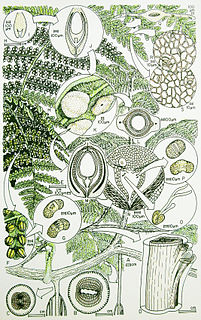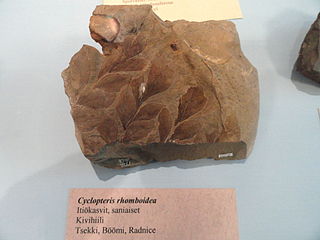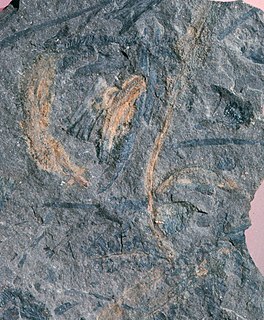 W
WThe term Pteridospermatophyta refers to several distinct polyphyletic groups of extinct seed-bearing plants (spermatophytes). The earliest fossil evidence for plants of this type is the genus Elkinsia of the late Devonian age. They flourished particularly during the Carboniferous and Permian periods. Pteridosperms declined during the Mesozoic Era and had mostly disappeared by the end of the Cretaceous Period, though some pteridosperm-like plants seem to have survived into Eocene times, based on fossil finds in Tasmania.
 W
WThe term Pteridospermatophyta refers to several distinct polyphyletic groups of extinct seed-bearing plants (spermatophytes). The earliest fossil evidence for plants of this type is the genus Elkinsia of the late Devonian age. They flourished particularly during the Carboniferous and Permian periods. Pteridosperms declined during the Mesozoic Era and had mostly disappeared by the end of the Cretaceous Period, though some pteridosperm-like plants seem to have survived into Eocene times, based on fossil finds in Tasmania.
 W
WThe Alethopteridaceae are a family of extinct plants belonging to Pteridospermatophyta, or seed ferns.
 W
WAlethopteris is a prehistoric plant genus of fossil Pteridospermatophyta that developed in the Carboniferous period.
 W
WCallipteridium is an extinct genus of pteridospermous seed ferns belonging to the family Cyclopteridaceae. These ferns existed in the Carboniferous period.
 W
WThe Callistophytaceae was a family of seed ferns (pteridosperms) from the Carboniferous and Permian periods. They first appeared in late Middle Pennsylvanian (Moscovian) times, 306.5–311.7 million years ago (Ma) in the tropical coal forests of Euramerica, and became an important component of Late Pennsylvanian vegetation of clastic soils and some peat soils. The best known callistophyte was documented from Late Pennsylvanian coal ball petrifactions in North America.
 W
WThe Callistophytales was an order of mainly scrambling and lianescent plants found in the wetland "coal swamps" of Euramerica and Cathaysia. They were characterised by having bilaterally-symmetrical, non-cupulate ovules attached to the underside of pinnules that were morphologically similar to the "normal" vegetative pinnules; and small compound pollen-organs, also borne on the underside of unmodified pinnules, that produced saccate pollen. They were reproductively more sophisticated than most other Palaeozoic pteridosperms, some of which they seem to have out-competed and replaced in the "coal swamp" vegetation during Late Pennsylvanian and Permian times.
 W
WCaytonia is an extinct genus of seed ferns.
 W
WCaytonia nathorstii is an extinct species of seed ferns.
 W
WThe Caytoniales are an extinct order of seed plants known from fossils collected throughout the Mesozoic Era, specifically in the late Triassic to Maastrichtian period, around 250 to 70 million years ago. They are regarded as seed ferns because they are seed-bearing plants with fern-like leaves. Although at one time considered angiosperms because of their berry-like cupules, that hypothesis was later disproven. Nevertheless, some authorities consider them likely ancestors of angiosperms, whereas others consider angiosperms more likely derived from Glossopteridales. The origin of angiosperms remains an intriguing puzzle.
 W
WCorystospermaceae is a natural family of seed ferns (Pteridospermatophyta) also called Umkomasiaceae, and first based on fossils collected by Hamshaw Thomas from the Burnera Waterfall locality near the Umkomaas River of South Africa The leaves of Dicroidium were recognized by Alex Du Toit to unite all the countries of the Gondwana supercontinent during the Triassic: Africa, South America, India, and Australia. Subsequently, Dicroidium was found in the Triassic of Antarctica and New Zealand, and also the Permian Umm Irna Formation of Jordan. According to the form generic system of paleobotany, leaves are given separate generic names to ovulate and pollen organs, but the discovery of these reproductive organs in Africa by Thomas, and subsequently throughout Gondwana, strengthened Du Toit's concept of a continuous southern supercontinent. Corystospermaceae were also components of Jurassic and Cretaceous floras, declining in the Cretaceous presumably due to the rise of flowering plants, the last representative of the group, Komlopteris cenozoicus, is known from the Eocene of Tasmania.
 W
WThe Medullosales is an order of pteridospermous seed plants characterised by large ovules with circular cross-section, with a vascularised nucellus, complex pollen-organs, stems and rachides with a dissected stele, and frond-like leaves. Their nearest still-living relatives are the cycads.
 W
WCyclopteris is an extinct genus of seed ferns in the extinct family †Cyclopteridaceae. Species are from the Carboniferous.Cyclopteris elegans Lesquereux, 1854 - from the Carboniferous of Pennsylvania, USA Cyclopteris elegans Unger, 1858 Cyclopteris elegans Achepohl, 1883 - from Westphalia, Germany
 W
WDicroidium is an extinct genus of fork-leaved seed ferns that were widely distributed over Gondwana during the Triassic. Their fossils are known from South Africa, the Arabian Peninsula, Australia, New Zealand, South America, Madagascar, the Indian subcontinent and Antarctica. They were first discovered in Triassic sediments of Tasmania by Morris in 1845. Fossils from the Umm Irna Formation in Jordan and in Pakistan indicate that these plants already existed in Late Permian. Late surviving members of the genus are known from the Early Jurassic (Sinemurian) of East Antarctica.
 W
WDicroidium odontopteroides was a common and widespread species of Dicroidium known from South Africa, Australia, New Zealand, South America and Antarctica. The species was first discovered in Triassic sediments of Tasmania and described by the palaeontologist John Morris in 1845.
 W
WDicroidium zuberi is a large bipinnate species of the seed fern Dicroidium with a forked rachis. The leaves are affiliated with Umkomasia feistmantellii megasporophylls and Petruchus barrealensis microsporophylls.
 W
WDictyopteridium is an extinct genus of plants belonging to Glossopteridaceae, but the name is used only for compression fossils of elongate multiovulate reproductive structures adnate to Glossopteris leaves. Permineralized remains identical to Dictyopteridium have been referred to the organ genus Homevaleia
 W
WThe Glossopteridaceae are an extinct family of plants belonging to Pteridospermatophyta, or seed ferns.
 W
WGlossopteris is the largest and best-known genus of the extinct Permian order of seed ferns known as Glossopteridales. The genus Glossopteris refers only to leaves, within a framework of form genera used in paleobotany. Species of Glossopteris were widespread over the supercontinent of Gondwana during the Permian epoch, where they formed the dominant component of high latitude polar forests. Glossopteris fossils were critical in recognizing former connections between the various fragments of Gondwana: South America, Africa, India, Australia, New Zealand, and Antarctica.
 W
WLagenostoma is a genus of seed ferns (Pteridospermatophyta), based on ovules preserved in coal balls from the Six Inch Coal of the Hough Hill Colliery near Stalybridge, England. Distinctive stalked glands enabled Oliver and Scott to attribute these seeds to fernlike foliage of Sphenopteris hoeningshauseni in the same coal balls. This was the first recognition that some Carboniferous fernlike leaves had seeds, and so were not pteridophytes, but rather Pteridospermatophyta, or seed ferns. The realization that seed plants as well as spore plants had fernlike leaves was a major contribution to the evolutionary history of plants.
 W
WLepidopteris is a form genus for leaves of Late Permian to Late Triassic Period Pteridospermatophyta, or seed ferns, which lived from around 260 to 200 million years ago in what is now Australia, Antarctica, India, South America, South Africa, Russia and China. Nine species are currently recognized. Lepidopteris was a common and widespread seed fern, which survived the Permian-Triassic extinction event but succumbed to the Triassic-Jurassic extinction event. Lepidopteris callipteroides is especially common between the first two episodes of Permian-Triassic extinction event, and L. ottonis forms a comparable acme zone immediate before the Triassic-Jurassic extinction event.
 W
WLepidopteris callipteroides is a form species for leaves of Late Permian Pteridospermatophyta, or seed ferns, which lived from around 252 million years ago in what is now Australia, and Madagascar. Lepidopteris callipteroides was an immediate survivor of the largest Permian-Triassic extinction event, migrating southward with the post-apocalyptic greenhouse spike.
 W
WThe Lyginopteridales were the archetypal pteridosperms: They were the first plant fossils to be described as pteridosperms and, thus, the group on which the concept of pteridosperms was first developed; they are the stratigraphically oldest-known pteridosperms, occurring first in late Devonian strata; and they have the most primitive features, most notably in the structure of their ovules. They probably evolved from a group of Late Devonian progymnosperms known as the Aneurophytales, which had large, compound frond-like leaves. The Lyginopteridales became the most abundant group of pteridosperms during Mississippian times, and included both trees and smaller plants. During early and most of middle Pennsylvanian times the Medullosales took over as the more important of the larger pteridosperms but the Lyginopteridales continued to flourish as climbing (lianescent) and scrambling plants. However, later in Middle Pennsylvanian times the Lyginopteridales went into serious decline, probably being out-competed by the Callistophytales that occupied similar ecological niches but had more sophisticated reproductive strategies. A few species continued into Late Pennsylvanian times, and in China persisted into Early Permian (Asselian) times, but then became extinct. Most evidence of the Lyginopteridales suggests that they grew in tropical latitudes of the time, in North America, Europe and China.
 W
WThe Lyginopteridales were the archetypal pteridosperms: They were the first plant fossils to be described as pteridosperms and, thus, the group on which the concept of pteridosperms was first developed; they are the stratigraphically oldest-known pteridosperms, occurring first in late Devonian strata; and they have the most primitive features, most notably in the structure of their ovules. They probably evolved from a group of Late Devonian progymnosperms known as the Aneurophytales, which had large, compound frond-like leaves. The Lyginopteridales became the most abundant group of pteridosperms during Mississippian times, and included both trees and smaller plants. During early and most of middle Pennsylvanian times the Medullosales took over as the more important of the larger pteridosperms but the Lyginopteridales continued to flourish as climbing (lianescent) and scrambling plants. However, later in Middle Pennsylvanian times the Lyginopteridales went into serious decline, probably being out-competed by the Callistophytales that occupied similar ecological niches but had more sophisticated reproductive strategies. A few species continued into Late Pennsylvanian times, and in China persisted into Early Permian (Asselian) times, but then became extinct. Most evidence of the Lyginopteridales suggests that they grew in tropical latitudes of the time, in North America, Europe and China.
 W
WLyginopteris is a genus of Late Carboniferous seed fern stems with a very distinctive outer cortex of sclereids forming a pattern in cross section like Roman numerals on a clock face, often called a Sparganum cortex. Some Lyginopteris were parasitized by water molds.
 W
WMacroneuropteris is a genus of Carboniferous seed plants in the order Medullosales. The genus is best known for the species Macroneuropteris scheuchzeri, a medium-size tree that was common throughout the late Carboniferous Euramerica. Three similar species, M. macrophylla, M. britannica and M. subauriculata are also included in the genus.
 W
WThe Medullosales is an order of pteridospermous seed plants characterised by large ovules with circular cross-section, with a vascularised nucellus, complex pollen-organs, stems and rachides with a dissected stele, and frond-like leaves. Their nearest still-living relatives are the cycads.
 W
WMoresnetiaceae is a natural family of seed ferns in the Division Pteridospermatophyta that appears in the North American and European Devonian to Carboniferous coal measures.
 W
WThe Medullosales is an order of pteridospermous seed plants characterised by large ovules with circular cross-section, with a vascularised nucellus, complex pollen-organs, stems and rachides with a dissected stele, and frond-like leaves. Their nearest still-living relatives are the cycads.
 W
WNeuropteris is an extinct seed fern that existed in the Carboniferous period, known only from fossils.
 W
WThe Medullosales is an order of pteridospermous seed plants characterised by large ovules with circular cross-section, with a vascularised nucellus, complex pollen-organs, stems and rachides with a dissected stele, and frond-like leaves. Their nearest still-living relatives are the cycads.
 W
WPeltaspermaceae is a natural family of seed ferns (Pteridospermatophyta) widespread in both northern and southern hemispheres coal measures of Permian and Triassic age.
 W
WPteruchus is a form genus for pollen organs of the seed fern (Pteridospermatophyta family Umkomasiaceae. It was first described by Hamshaw Thomas from the Umkomaas locality of South Africa.
 W
WPteruchus africanus is a pollen organ of a seed fern (Pteridospermatophyta). It was first described by Hamshaw Thomas from the Umkomaas locality of South Africa.
 W
WPteruchus barrealensis is an unusually large species of Pteruchus with very elongate polleniferous heads from Early Triassic of Australia and Argentina.
 W
WSagenopteris is a genus of extinct seed ferns from the Triassic to late Early Cretaceous.
 W
WSagenopteris phillipsii are leaves of extinct species of seed ferns.
 W
WSagenopteris trapialensis are leaves of extinct species of seed ferns from Chubut, Patagonia Argentina. At the moment, S. trapialensis is based on impression fossils found in the Early Jurassic Lonco Trapial Formation near Paso del Sapo, Chubut Province.
 W
WSphenopteris is a genus of seed ferns containing the foliage of various extinct plants, ranging from the Devonian to Late Cretaceous.
 W
WStamnostoma is an extinct genus of seed ferns based on cupules with seeds. These are among the earliest known seed plants and of earliest Carboniferous (Tournaisian) age.
 W
WUmkomasia is a genus of seed ferns (Pteridospermatophyta), and first based on fossils collected by Hamshaw Thomas from the Burnera Waterfall locality near the Umkomaas River of South Africa. He recognized on the basis of cuticular similarities that the same plant produced pollen organs Pteruchus and the leaves Dicroidium.
 W
WUmkomasia feistmantelii is an unusually large species of Umkomasia from the Early Triassic of New South Wales, Australia.
 W
WUmkomasia macleanii is an ovulate structure of a seed fern (Pteridospermatophyta and the nominate genus of Family Umkomasiaceae. It was first described by Hamshaw Thomas from the Umkomaas locality of South Africa.
 W
WCorystospermaceae is a natural family of seed ferns (Pteridospermatophyta) also called Umkomasiaceae, and first based on fossils collected by Hamshaw Thomas from the Burnera Waterfall locality near the Umkomaas River of South Africa The leaves of Dicroidium were recognized by Alex Du Toit to unite all the countries of the Gondwana supercontinent during the Triassic: Africa, South America, India, and Australia. Subsequently, Dicroidium was found in the Triassic of Antarctica and New Zealand, and also the Permian Umm Irna Formation of Jordan. According to the form generic system of paleobotany, leaves are given separate generic names to ovulate and pollen organs, but the discovery of these reproductive organs in Africa by Thomas, and subsequently throughout Gondwana, strengthened Du Toit's concept of a continuous southern supercontinent. Corystospermaceae were also components of Jurassic and Cretaceous floras, declining in the Cretaceous presumably due to the rise of flowering plants, the last representative of the group, Komlopteris cenozoicus, is known from the Eocene of Tasmania.